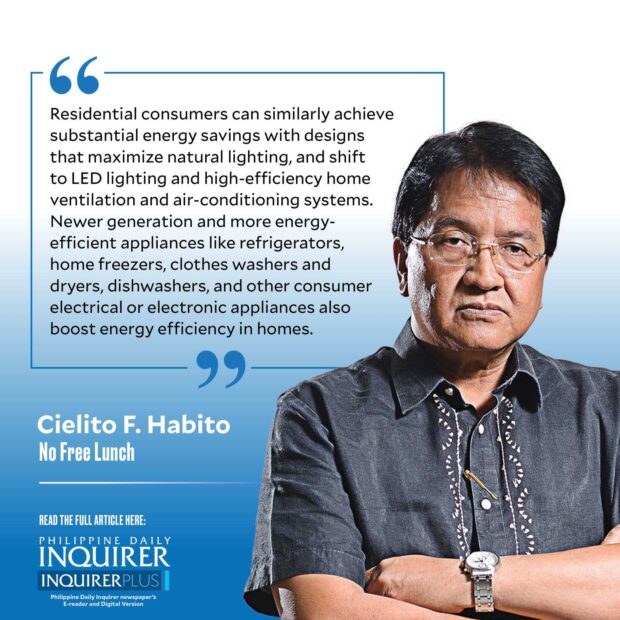
There is too much focus on the supply side in discussions about fixing our recurring summer power shortages, rues energy efficiency champion Alexander Ablaza, president of the Philippine Energy Efficiency Alliance (PE2). He and PE2 argue that improved energy efficiency should be considered our “first fuel” or “first dispatch” in the overall strategy to close the supply-demand gap—that is, prioritize the vast opportunities for reducing demand via efficiency improvements. Government and energy end-users can still do much on this, even as we’ve had energy efficiency and conservation plans since the 1990s, possibly earlier. Conservation is more widely understood and implies reducing energy-using activities, thereby entailing some deprivation. But improved efficiency means being able to achieve no less, and possibly more, with less energy expended.
A similar argument is made in agriculture circles that we could have far more supplies of farm products if we are able to cut excessive postharvest losses. Or that we could reach self-sufficiency in rice if only Filipinos opt to eat healthier unpolished rice, aka brown rice, with which we get an additional 10 percent milling recovery by foregoing the last step of polishing the grain to whiteness. These are considered “low-hanging fruit” solutions to our perennial problem with food supplies. In the same way, investments in improved energy efficiency are lower-hanging fruit to fix our energy gap, as they would not entail the years of gestation and hundreds of approval signatures needed to set up a new power plant. Investments in energy efficiency have the equivalent effect to investing in a new power plant, and must rightfully be part of the energy mix in the country’s energy development plan.
The major challenge within our power sector is the wide variation across the year and within a given day in our total power consumption. Ablaza cites the 3,340-megawatt rise in summer demand, peaking in April-May, now up to 27 percent higher than the seasonal low demand in January. Last year, demand peaked at 12,550 MW in Luzon, 2,458 MW in Visayas, and 2,315 MW in Mindanao, while projected peak demands this year are 13,917 MW, 2,891 MW, and 2,584 MW respectively. As overall system capacities are planned and installed to meet peak demands, this implies much capacity underutilization during low-demand periods, leading to wasteful inefficiency. That is why PE2 pushes for flattening the peaks as first recourse. Ablaza believes that much of the 3.3-gigawatt bump in summer demand could be flattened through either peak-shaving or load-shifting toward off-peak hours. He argues that our approach must begin by first exhausting all opportunities to flatten those daily and seasonal peak demand curves, before planning new power plants.
How could it be done? Ablaza asserts that the aggressive replacement of energy-intensive systems with more efficient technologies in the commercial, industrial, transport, and government sectors would achieve permanent peak shaving. These can take the form of shifting to LED lighting, using more energy-efficient motors, consumer electronics, and commercial refrigeration systems, and maximizing the use of sensors that automatically switch power off when not needed. More efficient cooling technologies are now available, such as district or centralized systems, and variable refrigerant flow, inverter, and solar thermal cooling systems that provide the precise amount of cooling needed vs traditional on-off mechanisms. Replacing conventional cooling systems with these would substantially reduce peak demand for cooling, which accounts for over 60 percent of peak power requirements in highly urbanized areas, especially through the midday and early afternoon hours. Energy-efficient building designs and materials that improve insulation or maximize ventilation for natural cooling are also important ways to boost energy efficiency.
Residential consumers can similarly achieve substantial energy savings with designs that maximize natural lighting, and shift to LED lighting and high-efficiency home ventilation and air-conditioning systems. Newer generation and more energy-efficient appliances like refrigerators, home freezers, clothes washers and dryers, dishwashers, and other consumer electrical or electronic appliances also boost energy efficiency in homes. Smart chargers can now communicate with batteries to ensure optimal charge and prolong battery life.
Ablaza further points to a wide range of energy storage technologies now available, including thermal, kinetic, and battery energy storage systems, to shift current peak demand to off-peak hours or periods. All told, investments in all these just need to be made more attractive. Incentives would help, and taken all together, the costs to society could be far less than setting up an equivalent new power plant.
cielito.habito@gmail.com